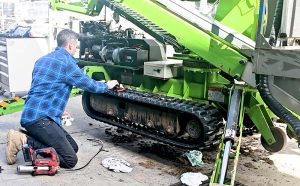What drives costs up?
Currently there has been a perfect storm of supply chain and macroeconomic drivers which have led to unprecedented price rises. Whilst the outbreak of COVID has certainly let the cat out of the bag, the foundations for this have been materialising and taking shape for several years now.
Firstly, the issue of energy supply – aftermarket parts whether steel or rubber require vast amounts of energy to produce. Whilst this article is not intended to comment on the current debates around global climate change, there is absolutely no doubt that attempts by governments around the globe to reduce carbon emissions and use of fossil fuels have led to energy shortages and thus huge price increases. The closing of coal fired power stations and even nuclear stations in Japan and Europe (typically among the cheapest forms of energy) coupled with the ongoing tensions between the East and the West have caused huge shortages of electricity. As yet, renewables have been unable to provide the base load requirements needed by industry. This has led to China, for example, rationing electricity supply and requiring factories to shut down during periods of extreme high or low temperatures.
The global energy supply problems have flowed through the entire supply chain, exacerbating the COVID related shortages of raw materials, extending lead-times and subsequently increasing costs. This is particularly evident in the shipping industry, vital for all import/export trade, which has seen shipping prices increase 400-500% in the past two years.
All these issues coupled with a severe manpower shortage (why work in a filthy, hot, and noisy steel mill if you can get the same money in an airconditioned office?) have caused unprecedented price increases of recent times. Heavy industry dependant products such as machinery parts have been particularly impacted with most suppliers raising prices by 30-50% in the past two years. Very few parts suppliers have passed these increases on in entirety, a lot of it has been absorbed, but how long can that be sustained?
What keeps costs down?
Australia is a resource rich country with not a lot of industrial manufacturing capacity. We mainly grow things or dig them out of the ground, send them overseas as raw materials and buy them back at a higher price once they have been processed, refined or machined. So, whilst the current high prices of grain, coal, iron ore, gas, etc. are good for exports, they have the impact of increasing the cost of imports. There is however a factor that makes even more impact – the exchange rate. Most foreign trade, whether imports or exports, are conducted in USD. The closer in value the Aussie is to the USD, the more we can get for our money. During COVID the exchange rate got down as low as $0.64 – so a part costing $100USD from the factory effectively costed $156.25 AUD and this is inescapable. All importers buy on the same market, so the entire industry is impacted the same. Of recent months, the exchange has been hovering around $0.70 – giving the same part a cost of $142.85 AUD, an 8.5% reduction. This has helped balance some of the cost increases experienced by Australian importers that have not been able to be passed on to the market.
The other major factor keeping costs down in Australia is the shortening of the supply chain. The middleman is being squeezed out. Factories are wanting to sell direct to the distributor rather than the more traditional sales agent, hence removing an entire level of margin. The car industry in particular, following Tesla’s lead, is pushing towards this new structure, with company owned outlets rather than independent dealers. I’m sure we will see more and more examples of this in coming years.
Why are some companies so expensive?
In every industry there is often a number of boutique and highly specialised suppliers. These suppliers will often provide exceptional levels of product knowledge and service within the narrow confines of their expertise. This narrow specialisation however often leads to reduced stock holdings and the requirement to rely on purchasing from other wholesalers leading to additional costs. If you have a very specific issue or problem to be solved then it is often worth paying the premium to get the specialist troubleshooting and help.
At the end of the day, each company is responsible to identify the market segment they want to play in and to ensure their product range suits that market. For example, a hobby farmer will likely be satisfied with a cheap Chinese tractor which would just not stand up to the rigors of a commercial agribusiness. As a result, there will always be tiers of pricing in any industry, but some factors will remain.
Why are some companies so cheap?
You get what you pay for – many Chinese factories offer quality tiers of product. Whilst the end product may look the same, steel quality (basic mild versus wear resistant alloys), heat treating process (requires vast amounts of energy and reducing heat or time saves money but reduces depth and or hardness) and substitution of high-quality virgin raw materials with recycled or synthetics all have a huge impact on cost. What makes evaluation so difficult is that poor steel or rubber looks the same as good steel or rubber, it takes a materials engineer to test the difference (or a year of usage on an Australian job site!!).
Volume versus service is another key factor. The old saying is price, quality and service; you can have any two but not all three. We see large “generalist” suppliers trying to be all things to everyone. Such businesses rely on pushing huge volumes, thus necessitating a highly competitive pricing strategy in order to succeed. This typically leads to a reduction in service levels and, sadly, that is mostly only experienced when things go wrong. There is no margin left to fix the problem and the sales staff are highly incentivised to get the next sale, leaving the customer holding the can.
Where does TKV fit?
Here at TKV we believe that we have a duty to run a profitable and sustainable business and we do not apologise for that one bit. It is so that we can be here for our customers. It is that profit that gives us the stability and resource to keep moving. We have been in business supplying machinery parts since 2004 – that’s now eighteen years, and we intend to be doing the same in another eighteen years.
As an astute customer, it is much more important to ensure that your supplier is stable, not just cheap. Will they be there when you need them and do they have the resource to fix any issues that arise?
Carrying stock costs money, TKV invests hugely in inventory. When your machine is down with a broken track in the field, a track that is $200 cheaper but 3 months away is of no use or consequence. We are track people, and tracks are what we stock.
At TKV, our long-range outlook leads us to choose our suppliers carefully and strenuously monitor the quality of our products. There is no future in selling rubbish; it would destroy our reputation. Instead, whilst we do not expect to be the cheapest our promise is we will only sell you a product that we can stand behind and will back with confidence.


